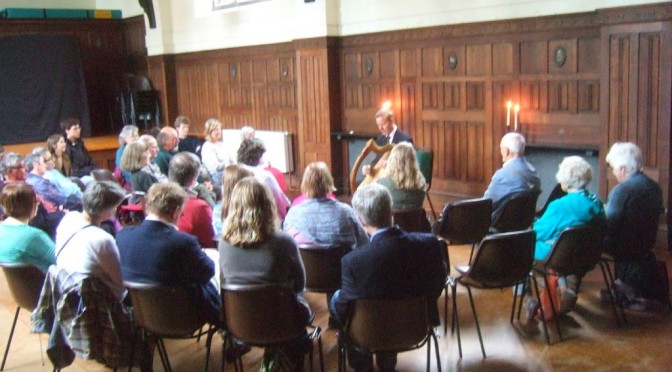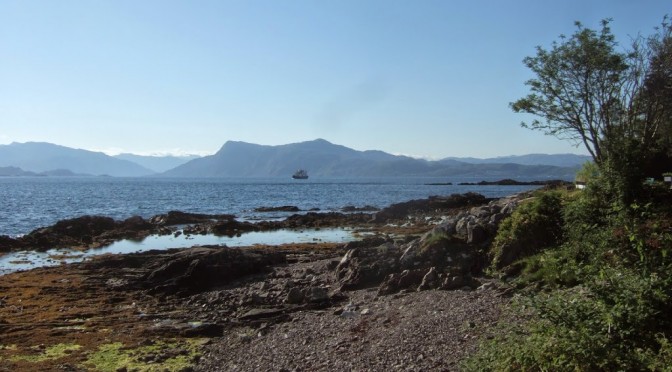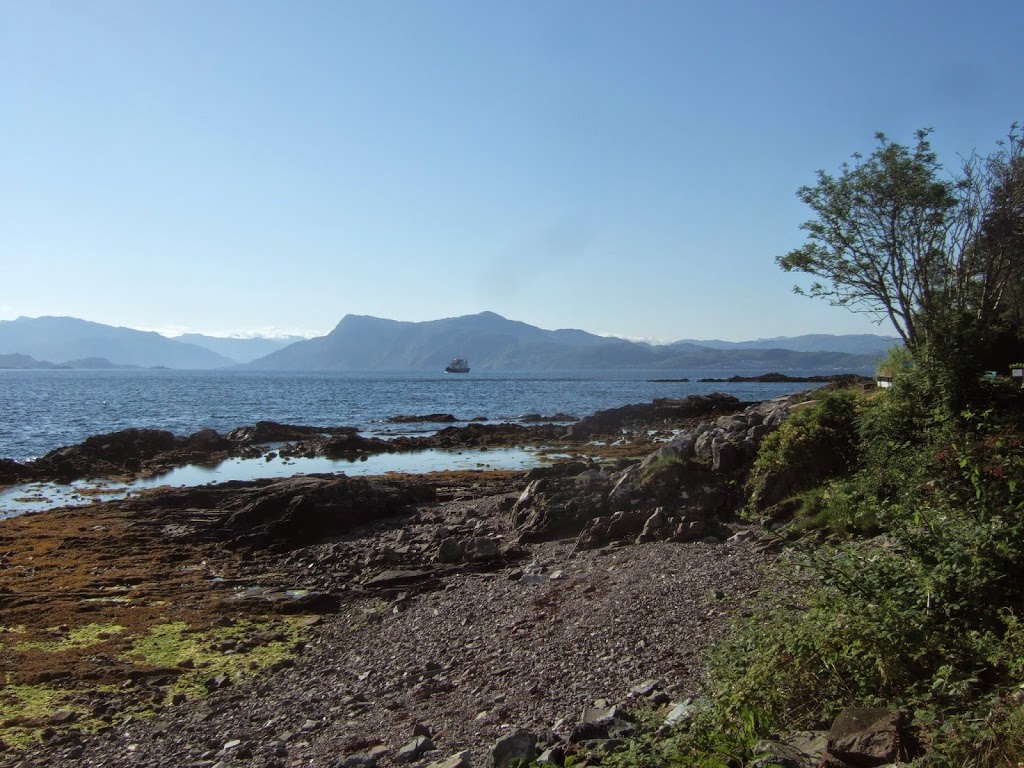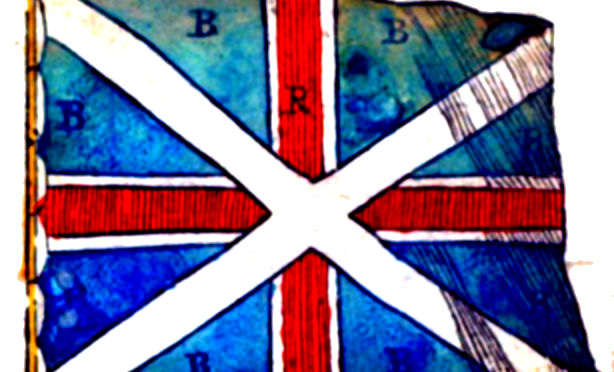Here’s the first photo I have seen so far from the Ceòl Rígh Innse Gall concert at the Museum of the Isles, Armadale, on the Isle of Skye a couple of weeks ago.
Tag: concert
Today’s concert in St Andrews
Here’s a rather fuzzy photo of today’s concert. I enjoyed having the candles lit! We had a reasonable turnout and the music went down well – two of Ranald‘s tunes from my Tarbh CD.
The crowdfunding at Indiegogo finishes tonight – last chance to tip a few pennies in the hat!
Medieval bardic poetry recital at Armadale, Skye
Yesterday evening I was in Sleat, presenting the medieval Gaelic poetry addressed to the Clan Donald Lords of the Isles, alongside Gaelic singer Gillebrìde MacMillan. We did two different hour-long sets, the first a more formal presentation in the atmospheric acoustic of the Museum of the Isles, and the second after a delicious buffet supper in the Victorian Stables building on the Armadale estate.
The audience, who comprised the great and good of Clan Donald, were entranced and delighted by Gillebrìde’s singing of the classical Gaelic verses praising their 12th and 13th century ancestors Angus Og as well as Donald himself.
As well as playing the harp to accompanying Gillebrìde’s delivery, I also did some solo harp tunes on the replica Queen Mary harp, including Cogaidh no Sith. I was delighted to get the same reaction as when I played it in St Andrews – people said it mesmerised them and seemed much shorter than the 15 minutes (I played a half-version with only 6 variations).
I understand there was some videotape made as well as photographs – I have not seen any of this yet though.
Sleat was beautiful; this morning I woke up early and walked down through a wooded valley to a secluded bay where I was able to swim in the sunshine before going back to the B&B for a hearty breakfast with fresh local eggs and strawberries.
Here’s the view across to Morar while waiting on the 8:30am ferry this morning:
I am really looking forward to repeating some of this material with Gillebrìde on Sunday 29th at the MacMhuirich Symposium. Do come along if you can, at 7pm at the Western Club, 32 Royal Exchange Square, Glasgow G1 3AB.
Lament for the Union recording
I have recorded the Lament for the Union programme and I am putting it out as a handmade CD single!
http://www.earlygaelicharp.info/union/ will get you the details as well as a sample track.
It’s not officially released until 1st July, but I have made up some pre-release copies to take along to tomorrow morning’s performance, 11.30am at Cupar Corn Exchange.
Lament for the Union
I have long been interested in the organisation of society, the use of symbols and ideas to motivate people and populations, and the structures and institutions that express and control the aspirations and ideas of peoples. Many years ago I got hold of a copy of Uniting the Kingdom (ed. Grant & Stringer, 1995), a book of historical essays on the relations between Scotland and England from earliest times through to the present day. From that point of view the current Union is a curious and unusual settlement.
I find it very interesting to be here at the time of the referendum, when people are talking passionately on all sides about the way that the nation and the state and society are set up, administered and controlled.
 I have for some years been aware of the pibroch titled “Lament for the Union”. Now that I have finally got it up and running as a harp tune, I love it! The ground is a plaintive, emotional lament, full of regret and pathos. The variations by contrast are very different, with unexpectedly changing rythym from 4-time to 3-time and back to 4 time, and with a brooding, urgent, almost menacing sequence of theme notes, and a progression of gestures which becomes quite frantic, like the excited chattering of political activists.
I have for some years been aware of the pibroch titled “Lament for the Union”. Now that I have finally got it up and running as a harp tune, I love it! The ground is a plaintive, emotional lament, full of regret and pathos. The variations by contrast are very different, with unexpectedly changing rythym from 4-time to 3-time and back to 4 time, and with a brooding, urgent, almost menacing sequence of theme notes, and a progression of gestures which becomes quite frantic, like the excited chattering of political activists.
I have put together a programme of a few other tunes with direct connection to the political events of three hundred years ago, when Scotland and England stopped being independent nations and joined together as a united kingdom. I will be playing this new programme for the first time at a referendum-themed art exhibition in Cupar this coming Saturday. I don’t know how many people we will get turning up at 11.30am on a Saturday morning but either way it will be a good opportunity for me to shake down this new programme!
‘Hear the Nation’
Saturday 21st June 2014 , 10.00 am – 4.00 pm
featuring contributions from
‘Yes’, ‘No’ and ‘Undecided’ writers, artists, and musicians
Harp Concert in St Andrews
Today was the first in my series of lunchtime harp concerts in St Andrews. This is the first year that we have not been running these in the Cathedral ruins so I was apprehensive both about the new venue, and how many people would come.
 In the end the venue was wonderful. All Saints church hall is a very atmospheric place, with lovely carved oak panelled walls decorated with painted wooden plaques, and big high arched windows letting the light from the sky stream in. The acoustics of the room are very nice for the harp as well.
In the end the venue was wonderful. All Saints church hall is a very atmospheric place, with lovely carved oak panelled walls decorated with painted wooden plaques, and big high arched windows letting the light from the sky stream in. The acoustics of the room are very nice for the harp as well.
Turnout was modest, but no less than we used to get at the cathedral for the first event of the season.
I played Cogadh no Sith, an epic half-hour pibroch. People were entranced; more than one commented that it felt like a lot less than half an hour, how they were “sucked in” to the music.
I’m looking forward to the next in the series on 2nd July already!
Ceol Rìgh Innse Gall – Music for the Lords of the Isles
“There IS Joy with Clan Donald”.
Harp concerts in St Andrews
Every summer from 2007 to 2013, I have performed a series of summer concerts for Historic Scotland at St Andrews Cathedral ruins. Unfortunately from 2014 the Cathedral are no longer able to host this popular series.
However, I really wanted to continue with this fine tradition and so we have booked All Saints Church hall on North Castle Street in the heart of old St Andrews. This is a nice arts-and-crafts venue, and I have used it before for a concert.
I also wanted to keep the concerts as free admission events as they have been since the very beginning.
This is where you come in. In the absence of reliable institutional funding, would you be able to help keep this series going as one of the highlights of the summer season in St Andrews?
I have set up an indiegogo crowdfunding page at igg.me/at/harp
Any amount that you are able to contribute will be a great help towards the costs of running this series.
I am planning to run four concerts, on the first Wednesday of each month from June through to September, at 12.45pm.
You can see details of the proposed programmes on the website at
http://www.simonchadwick.net/summer/
Please pass this on to any friends you know who would be interested in helping support the harp concert series. And I hope to see you at the concerts!
Hidden Door festival
Last night I was playing at the Hidden Door festival in Edinburgh’s old town. The festival itself was amazing, a beautiful collaboration of installation arts and performing arts. I loved the spontaneous nature of everything, and the DIY volunteer ethos of the festival organisers and the people running it on the ground. You do not find anything like this in St Andrews.
 Everything was set in disused vaults on Market Street – bare, spartan stone underground caverns. Some of them were music venues and some were spaces for art installations. I was particularly intrigued by an art installation in a completely blacked out vault, which consisted of a garden of lichtsuchende, robot plants, light sensitive and light emitting – torches were provided by the entrance curtain. There was also a very nice exhibition in another vault of framed collage pictures by Miriam Mallalieu on the theme of lichens. Some of the colours and structures in these images reminded me of some of Ealasaid’s work.
Everything was set in disused vaults on Market Street – bare, spartan stone underground caverns. Some of them were music venues and some were spaces for art installations. I was particularly intrigued by an art installation in a completely blacked out vault, which consisted of a garden of lichtsuchende, robot plants, light sensitive and light emitting – torches were provided by the entrance curtain. There was also a very nice exhibition in another vault of framed collage pictures by Miriam Mallalieu on the theme of lichens. Some of the colours and structures in these images reminded me of some of Ealasaid’s work.
I played in one of the vaults, which was a “hidden” music venue in amongst the installation art vaults. Unsuspecting art-lovers stumbled in and listened to some of the Tarbh music before leaving to explore the next installation. Sometimes I felt like some kind of strange robot flower in the centre of the vault, beneath a star-like lighting installation, playing this weird meditative music to an audience unprepared to hear it but open to new artistic experiences.
Scottish 78s
In six months time I have agreed to present a rather different programme for the Friends of Wighton – half an hour of ’20s sounds from old Scottish 78rpm gramophone records. It will be Wednesday 1st October, 1.15pm, in the Wighton Centre, Dundee Central Library.
I realised that I have plenty enough discs for half an hour – just one side of each from a selection will be more than enough. We will have Gaelic song, Scots song, fiddle, pipes and clarsach; the oldest disc is from about 1914 and the most recent from 1931.
I was also thinking about the dates and provenances of the various discs. The one shown above was recorded in London, though I assume it was made for the Scottish market. I have what I think is the oldest Scottish harp record, that is Patuffa Kennedy Fraser’s disc of “Songs of the Hebrides” from 1929. I also have what seems to be the oldest Irish harp record, Mabel Dolmetsch’s “Victorious tree”, recorded in 1937 though never released (I won’t be playing this one as it is too fragile as well as not being Scottish!)
Mabel’s record is Irish harp music but she wasn’t Irish or living in Ireland, so I wondered what was the oldest Irish harp record? Was Mabel first? Actually it seems she was. Susan Reed appears to have been the next to record, and her “Old English Folk Songs” released in 1945 would be the earliest published recording of Irish harp, even though the performer is American and the repertory is English! Mary O’Hara put out her first disc in 1956 I think. I’m having trouble tracking down other Irish harpists on record from this era.








